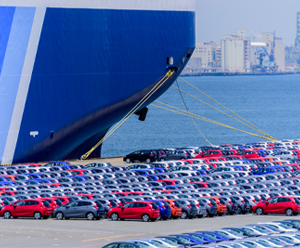
The fruits of Japan’s labor are worth their weight in gold

A single strawberry can be priced around €3,300 and a bunch of grapes can cost you €8,000. This is the price the Japanese put on the freshest and tastiest fruits painstakingly grown on their local farms.
Japan’s agriculture industry faces the challenge of limited land area. As such, Japan devotes most of this land to producing essentials such as rice and vegetables, while its fruits have become a premium delicacy.
“Craftsmanship is a strong part of our national character,” said a representative from the Hokkaido Agricultural Administration Office, Ministry of Agriculture, Forestry and Fisheries (MAFF), Business Support Division, Export Production Area Support. “Despite Japan having limited agricultural land, our farmers have taken pride in perfecting excellent innovative cultivation techniques and producing fruits of high quality.”
Serving agricultural royalty
Japan’s premium fruits are expensive because of their labor-intensive cultivation process and rarity. Unlike other countries, Japanese farmers cultivate and harvest their premium fruits entirely by hand. As the fruit ripens, it is not left to grow organically but is regularly turned around from time to time to ensure even exposure to sunlight.
“A normal cultivation can yield four to eight fruits from a single plant. But premium Japanese fruits are the best one or two fruits carefully selected, based on the sugar content and shape, from the harvest,” said the MAFF representative.
Grown in Central Japan’s Shizuoka prefecture, Yubari King Melons require 100 days to grow from seed to fruit. They are monitored daily, nurtured in temperature-controlled environments, given baths when they are dirty, and hats when they get too much sunlight. Furthermore, when the webbed textures of the melon appear, the farmers will hand-polish and massage each fruit. Yubari King melons are expensive because of the intense care they require, and only a select few make the cut each harvest season.
In Japan, fruit is considered a luxury item and plays an important and elaborate ritual part in Japan's extensive gift-giving practices. Regarded as symbols of respect, premium fruits are gifted during special occasions, or to socially important people, and are often used as offerings in temples or for ancestral prayers at home.
For instance, in 2019, a pair of Yubari King melons were auctioned in Sapporo with Pokka Sapporo Food & Beverage Ltd. winning with a bid of JP¥5 million (€41,000).
Another prime example of an expensive fruit gift is the square watermelon. Invented in 1978 by horticulturist and artist, Tomoyuki Ono, who patented the molding process for fruits, they are regular melons that were placed inside boxes to take on a square shape while growing, which makes them easier to transport, cut, and store than oval melons.
Topped with bows, square watermelons can command prices from about US$100 (€94) in Japanese stores, and as high as US$860 (€807) abroad.
Reaping the harvest
Ensuring that fruits remain fresh and beautiful throughout the shipment process requires substantial planning and coordination. Preliminary meetings with the customer and transportation schedules must be confirmed before the contract is accepted. The team may also send a sample shipment to the customer for them to assess the quality of the fruits and verify the suitability of the transportation plan.
These additional measures are necessary because of Japan’s strict quality grading of fruits. Apart from being assessed in terms of their shape and color, sugar content checks are also conducted using light sensor technology.
If a Japanese muskmelon has even slight imperfections, it will be given the lowest grade and sold at a much lower price —below US$50 (€47). Only one in 1,000 fruits can achieve the highest grade and those would command premium prices.
“Whenever we are asked to transport high-value fruits, we clarify whether any special arrangements are needed for the shipment because if any damage were to occur during transportation, it would impact our customers’ businesses. We need to ensure that we treat each shipment correctly and carefully,” said Karsten Michaelis, President/ Representative Director, DHL Global Forwarding Japan.
“Perishables, especially fruits, can be very sensitive to air and temperature changes,” noted Michaelis, who added that it is essential to transport and store fruits in a constant temperature range to maintain freshness. “Sometimes, we have to devise ways to prevent the cold air conditioner wind from blowing directly on the fruits stored in the warehouse.”
The DHL team is always on the lookout for sophisticated temperature-control and shock-minimizing technology for the fruits, and they are constantly looking for ways to minimize lead time and stabilize transport costs. Optimal flight plans are utilized, and items requiring temperature control are moved to a warehouse in a designated temperature zone for constant temperature control.
After it is cleared in export customs clearance, the cargo is delivered to the airline company warehouse and monitored until completion of loading on the designated flight. n the case of irregularities, recovery measures are promptly taken to ensure safe transportation to the destination.
“We handle all our cargo with the utmost care, regardless of price range,” said Michaelis. “We have to ensure that these fruits can arrive at the consumer’s destination at their freshest and tastiest.”
The legacy of Japan’s fruit farmers
Japanese fruit and vegetable exports are growing. In December 2022, export values were up nearly 500 percent on the 40-year average. Although January 2023 saw exports fall year-on-year by 15 percent, the next two months saw year-on-year increases.
“The international demand for premium fruit increased during the pandemic, as consumers started eating out less often and decided to make their nest eggs more upscale instead,” explained Michaelis.
He added that China, Hong Kong, and Taiwan are the biggest importers of Japan’s premium fruits. Fruits, such as Aomori Apples, are usually given as gifts during festive seasons like Chinese New Year because consumers view the high prices as corresponding to high quality, as well as a symbol of wealth.
However, on the supply side, farmers cultivating these premium fruits face a daunting labor shortage for skilled agricultural workers because of Japan’s aging demographics and dwindling rural population.
To overcome the labor shortage, farmers have turned to temporary workers or interns in Southeast Asia, as well as using fully automated mowers and drones to apply fertilizers and pesticides.
Japan’s fruit export industry also faces stiff competition from countries like China and Korea. Previously, Japanese farmers failed to register their fruit varieties overseas, leading to their fruits sprouting outside Japan. For example, the Shine Muscat grape varieties from Korea and China have been increasingly consumed in Hong Kong because of their lower price and aggressive advertising.
Despite the threat of Japanese fruits losing out in international competitiveness due to high costs, Japan’s farmers are staying focused on their artistic mastery. Japanese premium fruits are still extremely popular because of their high quality.
To prevent varieties of its premium fruits from sprouting outside of Japan, Japan’s MAFF has strengthened its intellectual property legislation, such as banning seeds and seedlings of some premium produce from being shipped out of the country. They have also amended their Plant Variety Protection and Seed Act in April 2021 to allow farmers to restrict growing areas and export destinations.
“If we fail to develop an environment where agricultural know-how is appropriately protected and utilized as intellectual property, the development of Japanese agriculture may be hindered by such competition,” said the MAFF in their Intellectual Property Strategy 2025.
ALSO WORTH READING
















 English
English